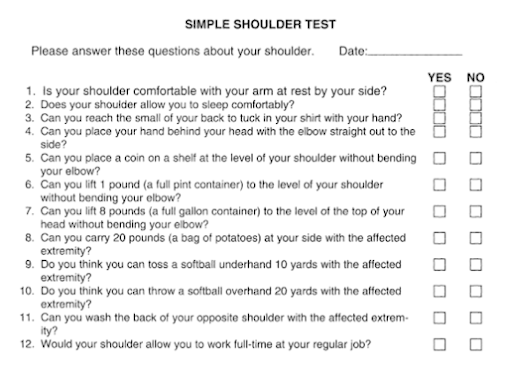A recent article, Thresholds For Diminishing Returns In Postoperative Range Of Motion After Total Shoulder Arthroplasty, pointed out that satisfaction after shoulder arthroplasty – can be associated with scores on patient-reported outcome measures (PROMs). (See Patient satisfaction after shoulder arthroplasty – anticipation and informing). In turn, PROMs are dependent upon restoring lost shoulder range of motion (ROM). The authors questioned whether there was a threshold in postoperative active ROM beyond which additional improvement in motion was not associated with additional improvement in the PROMs that primarily measured function (Simple Shoulder Test [SST], American Shoulder and Elbow Surgeons [ASES] score, and the Shoulder Pain and Disability Index [SPADI]). (Of note, other outcome measures, such as the Shoulder Arthroplasty Smart Score, primarily measure motion (70% of the total score) attributing only 10% of the points to function).
They included 4,459 TSAs (1,802 aTSAs, 2,657 rTSAs) with minimum 2-year follow-up. Indeed they found thresholds in postoperative ROM that were associated with no further improvement in the standard PROMs.
The “S” shapes of these curves are interesting. See for example the figures below plotting the patient’s Simple Shoulder Test (SST) responses against active flexion and active external rotation.


At the left side of these curves, improvement in motion has little effect on the number of SST functions the shoulder could perform. In the middle, there is a steep improvement in function with increasing range. At the right hand of the “S”, the curve flattens out so that further improvements in range are not strongly associated with increased function. For the SST the inflection points (thresholds) were 153 degrees for active flexion, 50 degrees of active external rotation, and active internal rotation to L2. Similar thresholds were found for other function-based outcome measures, including the ASES score and the SPADI.
Subjective satisfaction was assessed by asking patients to rate their shoulder as being “worse”, “unchanged”, “better”, or “much better” compared to before surgery. Among shoulders that achieved all ROM thresholds, 93% of patients rated their shoulder as “much better” compared to before surgery.

and the plane of elevation.


They learned that – rather than being confined to “abduction” and “flexion” – different functions were performed in different planes and with different angles of elevation.

It can be seen that the average maximum angle of elevation for eight normal subjects was 148 degrees, and that this range was not necessary for most of the activities of daily living.
Of course the ability to perform functions does not only depend on elevation angle and plane, but also on the rotation of the arm as shown below.

Comment to shoulderarthritis@uw.edu


